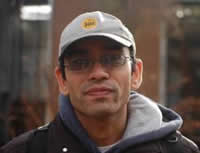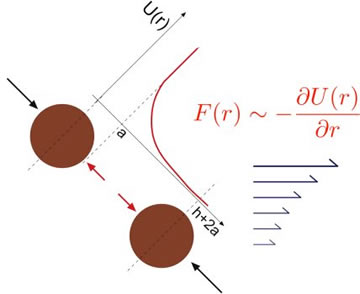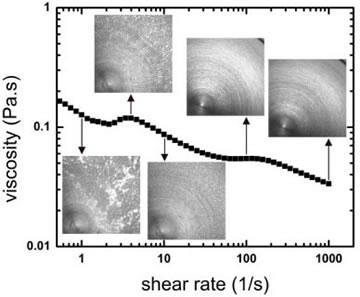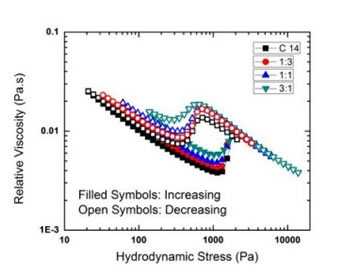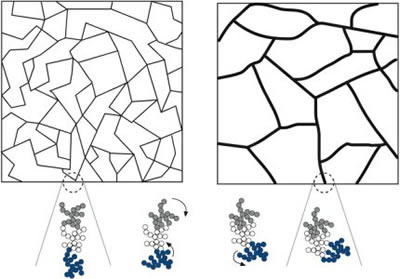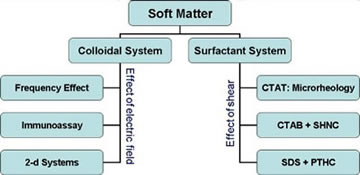B.Sc. (Honours) Physics, Acharya Narendra Dev College, University of Delhi, New Delhi, India 1998. M.S. in Physics, Department of Physics, Indian Institute of Science, Bangalore, India 2001. Ph.D. in Physics, Department of Physics, Indian Institute of Science, Bangalore, India 2008. I joined the Osuji lab in Feb 2008 as a post doctoral associate after completing my PhD in India in the lab of Prof. Ajay Sood. My research interests lie in the broad area of soft condensed matter physics. Soft matter encompasses systems whose constituents are supramolecular species of sizes much larger than conventional molecules. They exhibit numerous forms of self-organization and have significant structure and dynamics on mesoscopic length scales (~10 to 1000 nm). Notable examples include colloidal suspensions, ferro-fluids, emulsions, surfactant assemblies, liquid crystals, granular media and various biomaterials including DNA and proteins. These materials display a broad range of interesting microstructures and phase behaviours and have a myriad of applications in the materials, food, paint and cosmetic industries as well as medical technologies. Soft matter presents new opportunities and challenges for the development of new ideas and concepts in experimental and theoretical physics alike. Because the field overlaps with many different disciplines, the study of soft matter also offers promising developments to other fields of science including chemistry, chemical engineering, materials science, biology and environmental science. |
|||||
|
|||||
Colloidal suspensions are ubiquitous. Apart from natural colloidal suspensions like milk and blood, there are many others like paint, ink and cement which are technologically important. Their use in many industries like chemical, food, pharmaceutical, etc makes it essential to study and control the structure and flow properties of these suspensions. My post-doctoral work involves rheological investigations of colloidal suspensions. I use rheology combined with optical microcopy to study the structure and dynamics of these systems. I am particularly interested in studying gels formed by suspending fumed colloidal particles in hydrocarbon oils. These particles have fractal structure which results in interesting behaviours when suspended in a fluid. As these particles are suspended in non-polar hydrocarbon oils, the particles interact via attractive Van der Waals interactions. I am also studying colloidal glass formed by aqueous colloidal suspensions of disk-like particles of laponite. These particles interact via a repulsive electrostatic interaction. |
|||||
Topic 1: Shear Thickening Rheology of Attractive Colloidal Systems Dilute dispersions of fumed colloidal particles with attractive interactions in hydrocarbon fluids show two different shear thickening transitions (Figure 1). The shear thickening observed at higher shear rates is due to the breakdown of densified flocs and a concomitant increase in the effective volume fraction of the fractal particles in the fluid. This shear thickening is controlled by a critical stress (Figure 2) and accompanied by a positive increase in the first normal stress difference, N1, at the shear thickening transition. This is in contrast to the well-known hydrocluster mechanism of shear thickening in concentrated hard-sphere and repulsive systems (Figure 3). Gel elasticity depends strongly on the stress applied to suspensions in preshear, scaling roughly as the square of the preshear stress. At lower shear rates the increase in the apparent viscosity results from increased flow resistance due to the presence of gap-spanning log-like flocs in rolling flow.
Figure 3: In a compressional flow, the hydrodynamic force overcomes the repulsion between the particles leading to the hydrocluster formation resulting in shear thickening. |
Figure 1: Microstructures at different shear rates for a 2 wt% alumina dispersion in 3:1 oil+tetradecane fluid. |
||||
Figure 2: Ascending and descending sweep flow curves for 4 wt % carbon black in oil–tetradecane (C14) mixtures of 0:4, 1:3, 1:1, and 3:1 compositions. The shear rate is reduced to the hydrodynamic stress by multiplying by the viscosity of the solvent, producing superposition of the relative viscosities, indicating that shear thickening is controlled by a critical stress. |
|||||
|
|||||
Topic 2: Aging and Internal Stress Dynamics in Colloidal Suspensions Dilute suspensions of colloidal particles when subjected to shear rate quench, undergo gelation and show internal stresses which relax very slowly (Figure 4). The gels phase consists of sample spanning network of interconnected colloidal particles (Figure 5). Coarsening of these interconnections results in the aging behaviour in these systems. I am trying to understand the correlation between the internal stresses and aging dynamics in these systems. I am studying two different kinds of the systems - attractive colloidal gels formed by dispersions of carbon black particles in hydrocarbon oils and repulsive colloidal glass formed by aqueous laponite suspensions. |
Figure 4: Residual stress measured on cessation of shear from different shear rates. |
||||
Figure 5: The solid like behaviour of the colloidal gels is due to the network of interconnected colloidal particles. With time, these interconnections change which results in the modifications of the properties of these systems. This change in the properties of a system with time is termed as aging. |
|||||
Topic 3: Effect of Surfactant Additives on the Functioning of Engine Oil This is an industrial project for Chevron to develop a laboratory method for predicting the effects of surfactant additives on the performance of engine oils. Overtime, soot gets accumulated in the oil and increases the viscosity of the oil therby reducing its lubricating properties. To reduce this, surfactants are added to the engine oil. Surfactants get adsorbed on the surface of colloidal particles and reduce their ability to aggregate. The ability of different surfactants to adsorb differently will result in different efficacy of these surfactants. I use FTIR to determine the adsorption of different surfactants on carbon black particles in engine oils and collaborate this information with the rheological measurements on these systems. |
|||||
|
|||||
My PhD thesis "Soft Matter Under Electric Field and Shear" is divided into two main themes (Figure 6): First part involved the study of effects of electric field on aqueous colloidal suspensions (charge stabilised polystyrene spheres and functionalised antibody coated polystyrene microspheres) using optical microscopy and multiple particle tracking using digital video microscopy. Second part of my thesis was devoted to my studies on the rheology of aqueous surfactant systems. I used a rheometer to study aqueous solutions of mixed surfactant systems. The surfactant systems I studied are CTAB+SHNC in water and PTHC+SDS in water. I also studied aqueous surfactant system (CTAT in water) using video particle tracking microrheology. More details about my PhD work is available here. |
Figure 6: Organization of my PhD thesis. |
||||
|
Soft Condensed Matter Articles on ArXiv |
|||||
